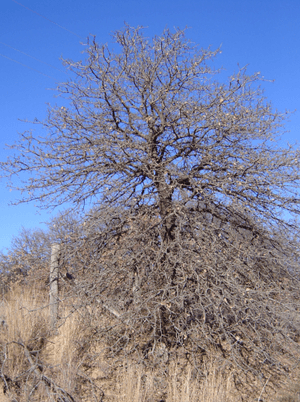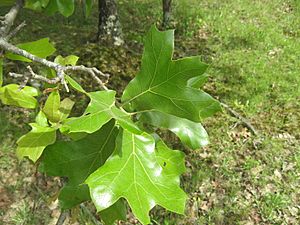Blackjack oak facts for kids
Quick facts for kids Blackjack oak |
|
|---|---|
 |
|
| Dormant blackjack in the Cross Timbers of Lincoln County, Oklahoma | |
| Conservation status | |
| Scientific classification | |
| Genus: |
Quercus
|
| Species: |
marilandica
|
 |
|
| Generalized natural range of Quercus marilandica | |
| Synonyms | |
|
|
The blackjack oak (scientific name: Quercus marilandica) is a small oak tree. It belongs to the red oak group. This tree grows naturally in the eastern and central parts of the United States. You can find it from Long Island in the east to Florida in the south. It also grows west into Texas, Oklahoma, and Nebraska. Some small groups have been seen in southern Michigan, but these were likely planted there.
The blackjack oak is a deciduous tree. This means its leaves fall off each year. It can grow up to 15 meters (about 50 feet) tall. Its bark is dark and cracked into rectangular plates. You might see narrow orange lines in the cracks.
Its leaves are 7 to 20 centimeters (3 to 8 inches) long and wide. They usually start narrow at the bottom and then get wider. They have three shallow lobes, making them look a bit like a bell. The top of the leaves is dark green and shiny. The underside is fuzzy. In the fall, the leaves turn red to brown. They often stay on the branches through the winter.
The acorns are small. They are about 12 to 20 millimeters (0.5 to 0.8 inches) long. They are also 10 to 18 millimeters (0.4 to 0.7 inches) wide. Like other red oaks, their acorns take 18 months to fully grow.
Contents
Where Blackjack Oaks Grow
Habitat and Distribution
The blackjack oak is a very tough tree. It can grow in poor, dry, or rocky soils. It also thrives in sandy areas. These are places where many other plants struggle to grow. You often find it on low ground, from sea level up to about 850 meters (2,800 feet) high.
Some people might say this tree is not as pretty as other oaks. However, it is very useful for difficult growing spots. It is a strong tree that can survive in harsh conditions. In the past, some blackjack oaks were even removed. This was done to make space for trees that were thought to be more valuable for business.
Growing Companions
Sometimes, the blackjack oak grows under pine trees. This happens on sandy hills in the southeastern US. Along the coast of New Jersey, you might find it in sunny, open spots. These areas are often near coastal salt marshes.
It often grows near scarlet oaks and post oaks. You might also see it with pitch pines. Other plants that grow nearby include winged sumac and bracken. You can also find sweetfern and bayberry with them. Blackjack oaks can be found as far north as parts of Ohio and New York.
The Cross Timbers Region
A special type of blackjack oak, Quercus marilandica var. ashei, grows in the western part of its range. This includes northern Texas, Oklahoma, and southern Kansas. In this area, blackjack oaks and post oaks create a unique landscape. It's a mix of forested strips and open prairie grasslands. This area is known as the Cross Timbers.
In Arkansas's Ozark plateau, scrubby blackjack oaks are common. They grow on rocky areas called chert glades. They often grow with post oaks there too.
Hybrids and Wildlife Food
Sometimes, the blackjack oak can mix with the bear oak. When they do, they form a new tree called Q. × brittonii. This is a type of hybrid tree.
In the Cross Timbers, blackjack oaks can grow 15 to 18 meters (50 to 60 feet) tall. Their trunks can be about 40 centimeters (16 inches) wide. But usually, they don't get taller than 12 meters (40 feet). Their leaves are 10 to 25 centimeters (4 to 10 inches) long and wide.
Blackjack acorns are an important food source. Both whitetail deer and wild turkey eat them. However, it's important to know that blackjack oaks can cause problems for cattle. The tree contains tannic acid, which can be harmful to cows if they eat too much.
Uses of Blackjack Oak Wood
The wood from blackjack oaks is very strong and heavy. When it burns, it creates a very hot flame. This makes it a great choice for barbecues and wood-burning stoves. It provides excellent heat.
However, this wood is not usually used in indoor fireplaces. The intense heat it produces can cause the wood to pop. This popping can increase the risk of house fires.
In Oklahoma, blackjack wood has a long history of use. It is traditionally used as both a fuel and a smoke wood for barbecue. It gives a special flavor to the food.
See also
 In Spanish: Quercus marilandica para niños
In Spanish: Quercus marilandica para niños




